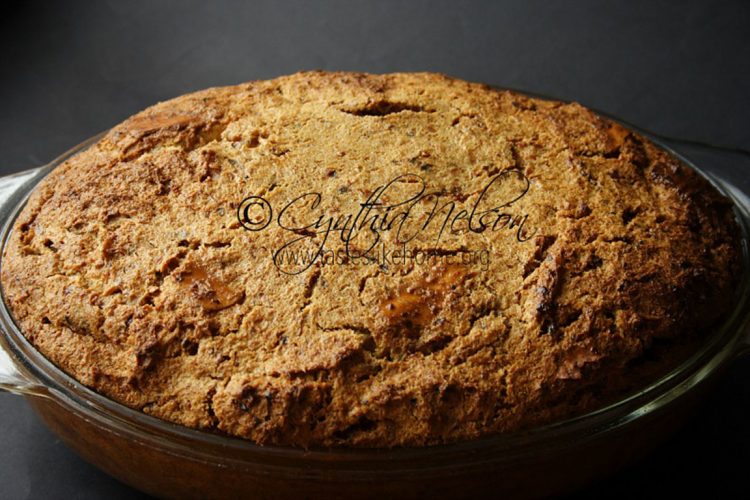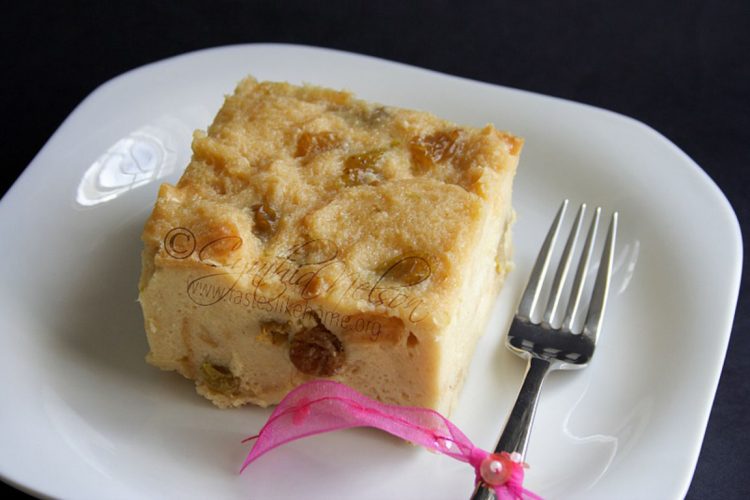What’s Cooking is a series in which I answer questions and share advice about food and cooking that you may have but are too shy to ask.
Question: “I often find bread pudding to be dry; Is that why it’s always served with a sauce?”
Bread pudding when done properly should be dense yet tender, pudding-like without being dry. A good bread pudding should be able to be eaten on its own without accompaniments such as a sauce or liqueur. Dry bread pudding arises from three issues – an insufficient quantity of custard to soak the bread, an inadequate amount time for the bread to absorb the custard and overcooking the pudding. It is important to add here that letting the bread pudding rest when it comes out of the oven is key to its final texture. And, bread pudding is best served warm or at room temperature, not hot, especially when reheated in a microwave oven. Let’s unpack.
Custard
The bare essentials of a custard for bread pudding are eggs, whole milk and sugar. Combine the three ingredients by whisking them together and you have the binding component of your pudding. The custard can be made richer by using heavy cream and/or evaporated milk in place of whole milk, and condensed milk instead of sugar.
With the custard base ready, it is time to add the flavourings – citrus zest, ground spices, extracts or essence – can all be used to flavour the custard which will ultimately flavour the bread pudding. Flavouring for a bread pudding can also come from the type of bread being used. For example, the use of cardamom bread, raisin loaf, any dried fruit loaf, or sweet bread loaf or roll instead of the standard white bread/roll.

The addition of fresh, dried, or cured fruits, chocolate chips, or Dulce de leche (a thick creamy caramel sauce) to bread pudding just before putting it into the oven also contribute to the flavouring of a bread pudding.
The quantity of custard needed depends on how much bread you are using to make the pudding; that will also be influenced by the type of bread being used. More on that in the section below on bread. When I am using a regular white bread loaf or roll, I average 1 egg for each heaped cup of cubed bread and ¾ cup of whole milk for each heaped cup of bread. Sugar, I add to taste.
Bread
Most, if not all, bread pudding recipes stipulate that you use “stale” as in day-old bread. The reason being that 24 hours later, the bread has dried out a bit and this condition makes it ideal to hungrily soak up the custard, getting in to every nook and cranny. You can use a combination of fresh and day-old bread if that is all you have on hand.

Breads are made with different types of flour and some have added ingredients. Breads made with whole grain flours will need more moisture (more custard). Rich bread doughs such as brioche, challah, cinnamon rolls also contain ingredients like milk, cream, butter, eggs and sugar. Making bread pudding with these breads impact (in a positive way) on the flavour and texture of the finished product. They elevate the humble bread pudding. If you find the crumb of the bread or roll you are using to be light and airy, then use less custard. Here’s what I do. I make the same amount of custard I would as if using a regular white loaf but only add three-quarters of the custard to the bread, I check on the soaked bread after it has been sitting for 6 hours, IF I find that the bread has absorbed almost all of the custard, I top it up with half of the custard I have remaining, after another 6 hours I check on it again and it usually just right – there is a thin film of custard at the top that will get absorbed by the time the setting period is over and it is time to bake the pudding.
Tip: steam the excess custard for a delightful, creamy dessert.
Absorption
Plan ahead when you are making bread pudding so as to avoid skimping on the time it takes for the bread to really absorb the custard. This stage is key to bread pudding yielding a tender crumb and not drying out when cooked. I recommend 15 – 18 hours of soaking in a refrigerator, of which 2 hours is for the pudding to come up to room temperature before baking. Two hours to come up to room temperature might seem like a long time but it is a good barometer because you want the pudding not to be cold when it goes into the oven or it will cook unevenly, potentially drying out parts of the pudding.
When you first combine the bread and the custard, be sure to spend a few minutes pressing the bread into the custard. You will notice at first that the bread floats a little, that’s because it is light and has not yet soaked up the custard, so help it along by continuously pressing it into the custard. If you remember, whenever you can, check on it and give the mixture a good stir and let it continue to soak.
Cooking
As I mentioned above, it is very important that the bread pudding be brought to room temperature before cooking.
There are two ways to cook the bread pudding in the oven – to pour the mixture into a buttered dish and bake directly, or, in a water bath. If baking the pudding in a water bath, the buttered dish with the bread pudding is placed into a larger baking dish, hot water is poured halfway up the sides of the inner pan and the pudding is cooked gently in the oven. Each method results in a different look and texture of the pudding; equally delicious, it is a matter of personal preference.
The bread pudding baked directly in its pan develops a crust all around and browns nicely. Be careful not to overcook it though; as soon as it domes fully (including the centre), remove it from the oven and put on a wire rack to cool. If will deflate and condense; that’s normal. If the pudding is baked in a water bath, there is no browning at the top, bottom or sides. Due to the gentle cooking with indirect heat, this version of the pudding has a somewhat creamy texture when you eat it. Just like custard, remove it from the oven when it has just set, carry over cooking will complete the process.
In both cases, always let the bread pudding rest and set before cutting and serving. If you used the water bath method, remove the dish from the hot water and cool on a wire rack.
Sauce or no sauce
Like I said, a good bread pudding should be able to stand alone, however, as with a lot of pudding type desserts, sauce is optional. If you are serving your bread pudding with a sauce or liqueur, let it be to enhance not mask that it is dry.
Cynthia
cynthia@tasteslikehome.org
www.tasteslikehome.org










